E-Museum of Pyrographic ArtAntique Art Hall
|
| - Café Flambé - | - Portraits and Paintings - | - Decorative and Applied Art - |
| - Folk and Traditional Art - | - Antique Art - | - Special Hall - | - Sculpture - |
| - Children's Hall - | - Bookstore and Library - | - Tools and Techniques - |
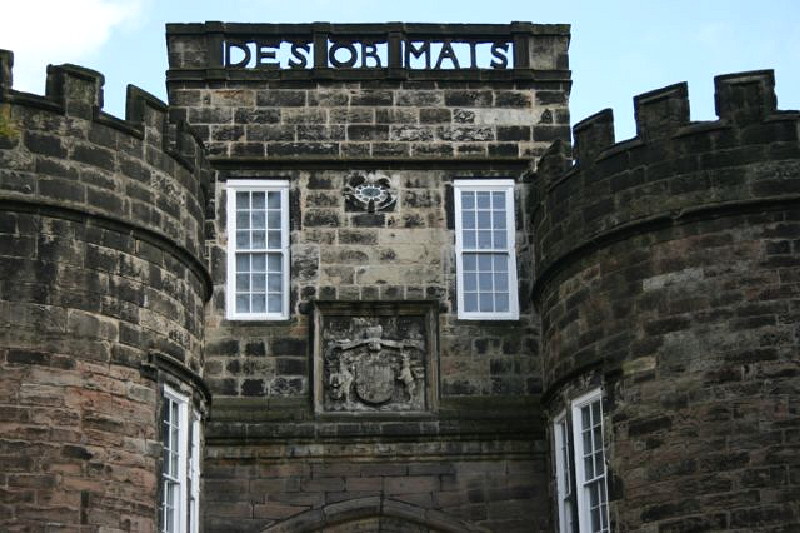 |
| 1. Studio of Smith, Pyrographist
Over the Castle Gate at Skipton "The castle passed from the crown to Robert de Clifford in 1310 and he probably built the outer gatehouse and curtain wall. The castle remained the ancestral home of the Cliffords for many centuries and it is their motto 'Desormais' ['Henceforth'] which adorns the top of the Grand Entrance. The Clifford tombs inside Holy Trinity Church are some of the most ornate in the country." —John Hague Photograph by John Hague |
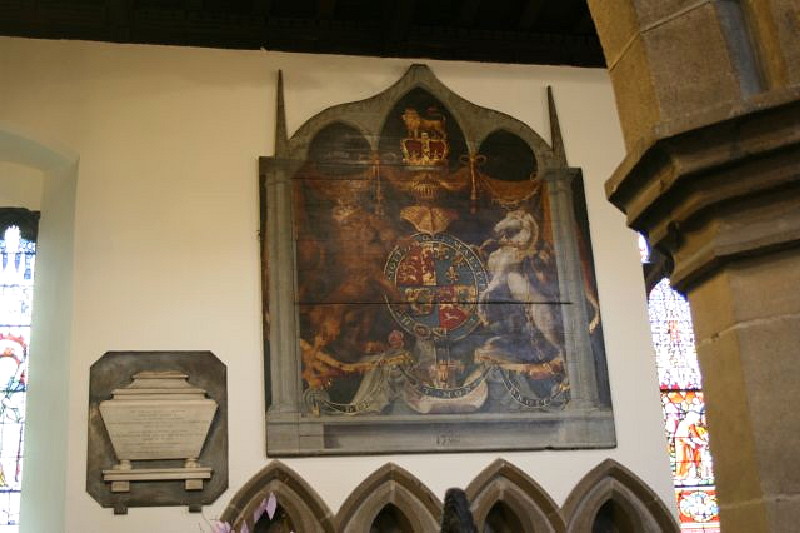 | ||||||
| 2. Royal Arms, View 1
By Smith, 1798 Painting on framed wood panel, Measures 9 ft. 4 in. wide (from outside of frame) | ||||||
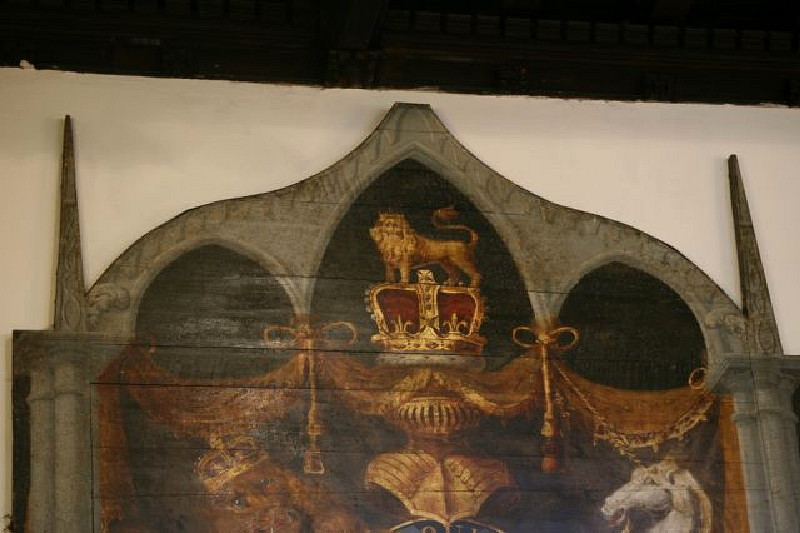 | ||||||
3. Royal Arms, View 2
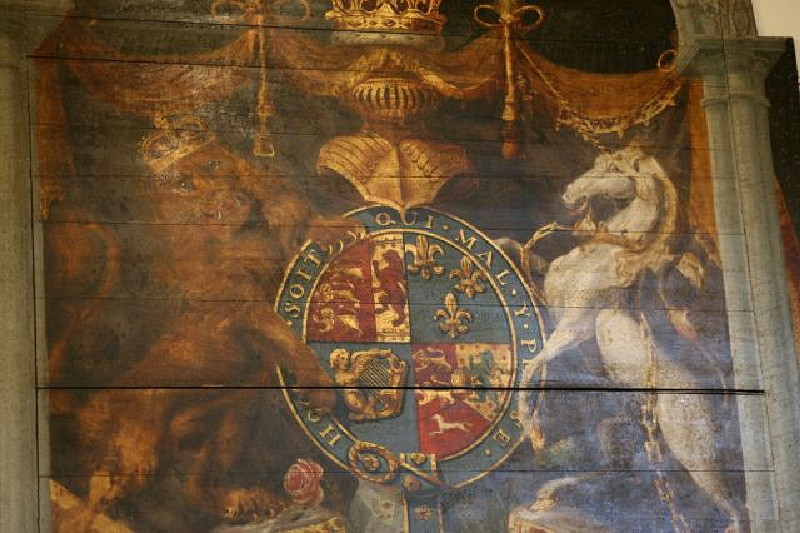 4. Royal Arms, View 3
| 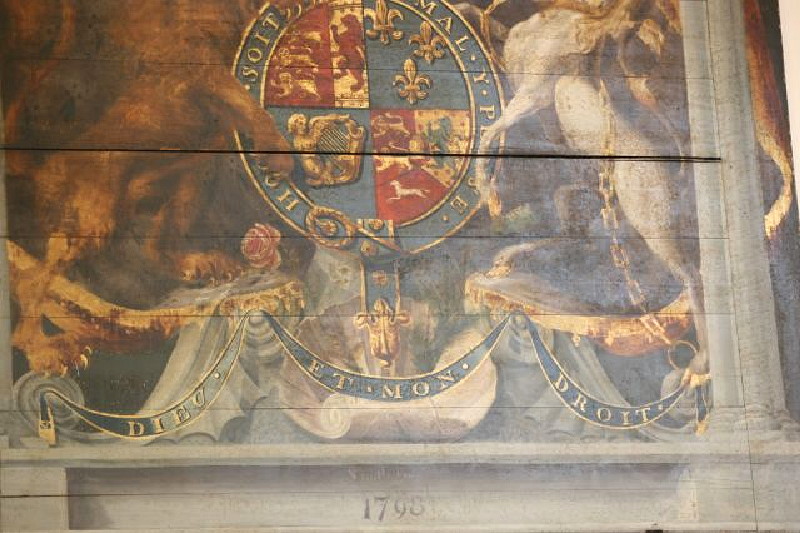 5. Royal Arms, View 4
| 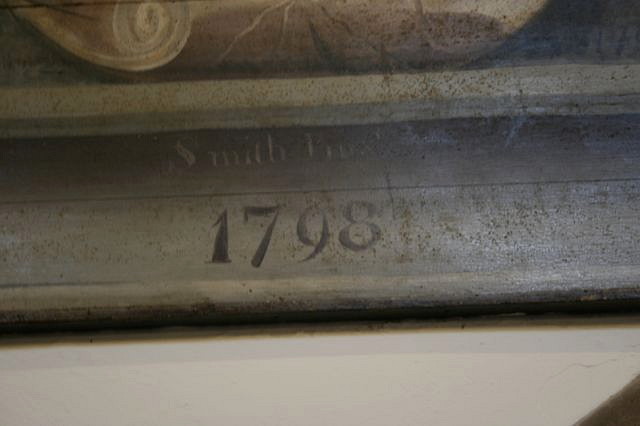 6. Royal Arms, View 5
| Showing the signature— 'Smith, Pinxt. [Note that Pinxt is the Latin convention of that time meaning "Smith painted" or, as we might write today "Painted by Smith"] Painting on framed wood panel, Measures 9 ft. 4 in. wide (from outside of frame) Photographs by John Hague |
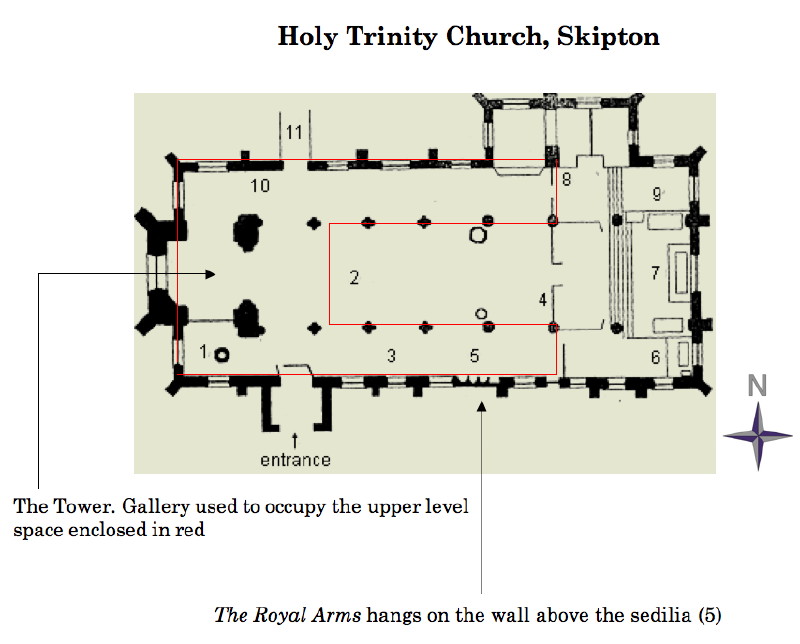 |
| 7. Diagram of Holy Trinity Church
With indications on Smith's works noted there by John Hague, 2011 |
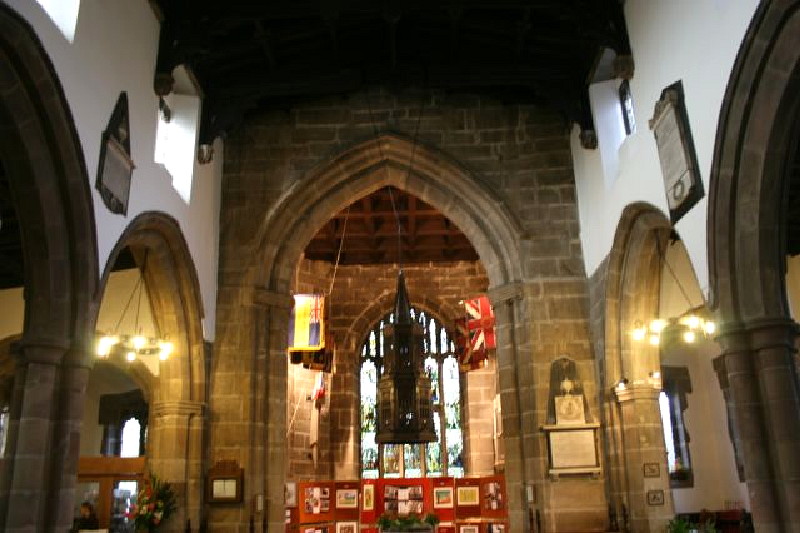 |
| 8. The Main Arch Holy Trinity Church
"[This] photo faces west and shows the main arch under the tower of Holy Trinity. When the gallery occupied that space (see photo 10), the 'Angel & Shepherds' would have hung under the top of the arch." —John Hague Photograph by John Hague, 2011 |
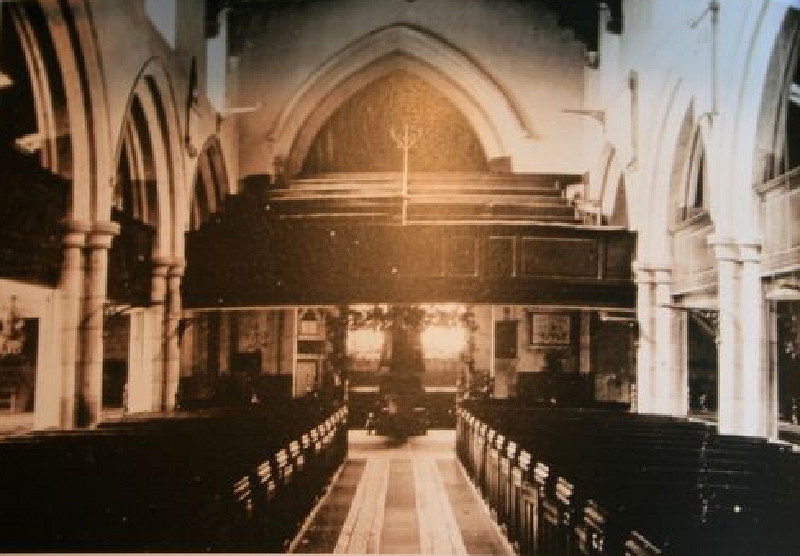 |
| 9. Interior of Holy Trinity Church in Skipton
"An early photo of the church with the gallery in place..." From Ken Ellwood's 2009 book, Skipton Through Time in which he notes " ...Mr Hird used a Thornton Pickard large plate camera to take this picture." —John Hague |
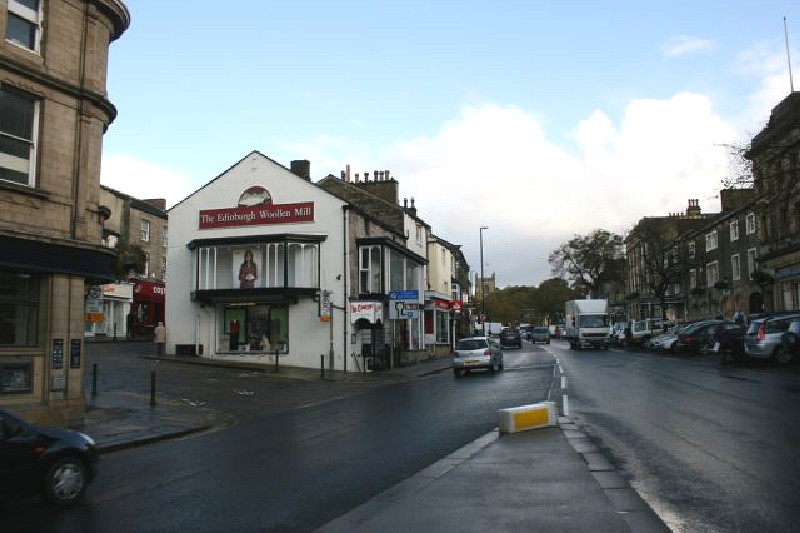 |
| 10. View of High Street in Skipton
The Edinburgh Woollen shop (white building on left) was once a Smith business (see following image below from circa 1875). Photograph by John Hague, 2011 |
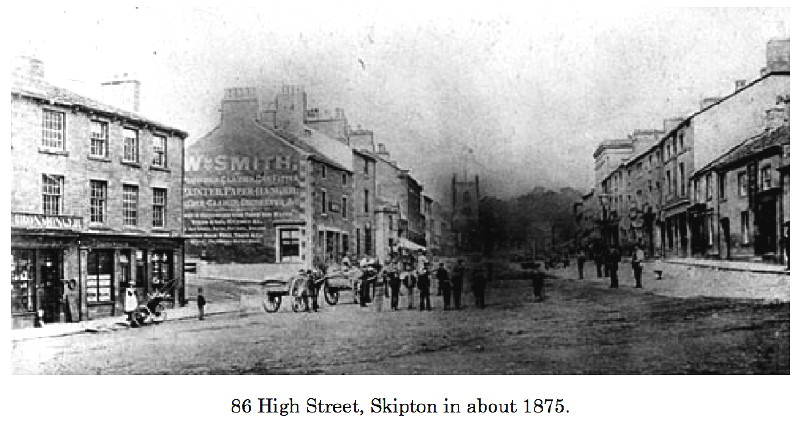 |
| 11. View of High Street, Skipton, Circa 1875
"...an 1875 photo of the shop when it was owned by William Smith, a nephew of Joseph. The shop as it is now is shown in my [previous] photo of the Edinburgh Woollen shop. Joseph Smith had the shop from about 1820 to 1851." —John Hague From the Rowley Collection of old photographs of Skipton |
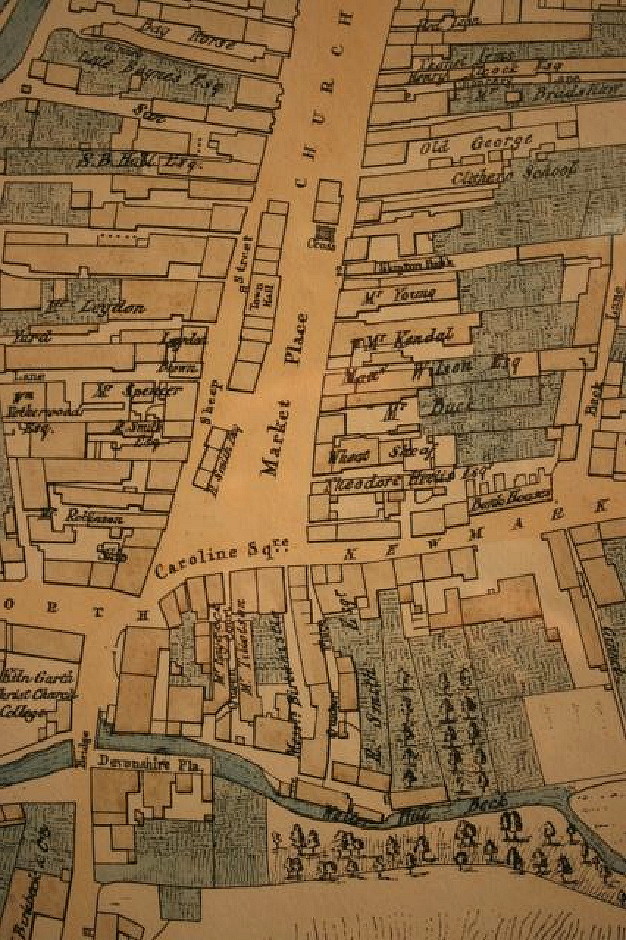 |
| 12. Map of Skipton (1832)
"The photo of [this] early Skipton map shows Smith's shop in Middle Row, the southerly property of the northern island of houses sandwiched by Sheep Street and Market Street (now High Street)." —John Hague |
John Hague, the proud owner of one of Joseph Smith's works—Portrait of a Merchant and his Partner—set out in October 2011 to research the artist in Skipton where he was said to have had his studio over the castle gate in the grand entrance there. In addition, two early works by Joseph Smith ('Royal Arms, 1798 and 'The appearance of the Angel to the Shepherds of Bethlehem', 1806) were documented as being in the Holy Trinity Church of Skipton. After returning from his research trip to Skipton (combined with a family visit), John sent the following travelogue-research paper to the E-Museum as background on the mysterious "Smith, Pyrographist" as the artist used to sign himself in an area where many with his surname lived. Following for your reading pleasure and further edification, the E-Museum offers, in his own words, John Hague's report on his research trip:
"[At] Skipton, we had a splendid welcome from the vicar of Holy Trinity, the Reverend Adrian Botwright, and his staff—who were all keen to hear what information I had about the artist responsible for The Royal Arms. ...It is still in situ in the church, but it does seem to have moved a little. It is now on the south wall above the four-seat sedilia (unusual itself, [as] these normally consist of three seats). That position accords with Harry Speight's description in 1891 ('Through Airedale from Goole to Malham'), while Harbutt Dawson in his 1882 'History of Skipton', places it on the north wall, adjacent to the organ. I've included a diagram of the church [image 7 above] noting the location of The Royal Arms and the space which used to be occupied by the gallery.
The piece is considerably larger than I'd expected and had to be photographed in place. I'd hoped to measure it, but could only manage the width, including the frame, which was 9 feet 4 inches. I presume one could work out what the height of the picture is from the photograph, but it is certainly taller than it is wide. As you can see from the photographs, it is signed 'Smith, Pinxt. 1798'.
More importantly, however, there seems to be no sign of poker-work on the picture—it is clearly painted on wood—in marvellous colours and with a keen sense of humour. The faces on the animals have a very human almost cartoon feel to them I thought. Hopefully the photos will give you a good idea of the piece.
There was, as expect[ed], no sign of the second Smith, The Annunciation [i.e., The appearance of the Angel to the Shepherds of Bethlehem].
I've included an early photo of the church with the gallery in place—probably taken just after 1900. From the anecdotal records, the picture would have hung in the space at the top of the arch. From research with the church, the gallery was dismantled in 1909 and there is no record of what happened to it or, indeed, the picture. As you can see, there is no sign of it in the photo and I'm quite intrigued by the change of tense in the 19th century references to it, viz., [the following]:
"At the back of the western gallery in the fine old church of Skipton-in-Craven is a clever 'Annunciation' from the irons of Smith" [1868 Notes & Queries];
"Smith executed the burnt painting which occupies the upper portion of the tower arch" [1882 Harbutt Dawson 'History of Skipton'];
"In the gallery, filling the opening in the tower arch, is a poker painting by one Smith." [1883 Yorkshire Archaeological Society];
"Over the gallery is a curious 'poker paint', burnt on sycamore wood, representing 'The Angel and Shepherds of Bethlehem'." [1891 Harry Speight]; but then two years later, Trimble talks in the past tense:
"Perhaps his best known work was that on the subject of 'The Annunciation' which hung for many years in the gallery of the fine old church of Skipton-in-Craven." [1893 Alfred Trimble 'The Collector'].
Does that suggest that the picture had already been taken down by the time the gallery was demolished?
My next angle is the attribution of the first name 'George' to the Smith responsible for The Royal Arms and The Annunciation. According to Harbutt Dawson, this seems to emanate from 'old church-wardens' records' and I've asked the Reverend Botwright to point me in the direction of where these records might be if they still exist. I do think it's relevant that Joseph Smith was responsible (from signatures) for the 1808 Grecian Lady/Dancing Muse pair which were signed 'Skipton Castle', and we know, from the 1868 Notes and Queries, that he was working from a studio above the grand entrance of Skipton Castle. The castle is right next door to the church and was a part of the castle via the Clifford family whose wonderfully ornate tombs grace the church. All that seems to cast doubt on the attribution of 'George'. I have been unable to find a contemporary George Smith who was an artist in the area, although there is one who was the landlord of the Nag's Head pub in New Market Street in 1822. There were, however, many Smiths in Skipton at that time.
By the by, Harbutt Dawson's History of Skipton notes that there was a portrait of Oliver Cromwell in the castle, and from description it sounds like one of the very few portraits of Cromwell which was not 'warts and all'. One oil painting in particular, which seems to match Dawson's description, is now housed in Gloucester Museum and in a bad state of repair. Maybe this was the inspiration for Smith's alleged poker-painting of Oliver Cromwell, although anecdotally the picture was a copy of Samuel Cooper's portrait of the Protector.
Records held by Skipton Library are extensive and we really didn't have enough time to do them justice. Birth and marriage records are good and I now have details of Joseph's birth, wife, marriage and eight children, three of whom died very young. One son, known as Stephen Catterson Smith the Elder, went on to have a distinguished career as the leading light of art in Dublin, Ireland, President of the Royal Hibernian Academy and a portrait painter of great repute. His own two sons, Stephen Catterson Smith the Younger and Robert Catterson Smith also pursued successful careers in art. Clearly something in the blood!
The photos of early Skipton maps (1832) show Smith's shop in Middle Row, the southerly property of the northern island of houses sandwiched by Sheep Street and Market Street (now High Street). I've attached an 1875 photo of the shop when it was owned by William Smith, a nephew of Joseph. The shop as it is now is shown in my photos of the Edinburgh Woollen shop. Joseph Smith had the shop from about 1820 to 1851."
In a subsequent correspondence in reply to some of the curator's questions, John had the following to say:
"I agree that it was disappointing to come up against the 'Pinxt.' vs. 'Pyrographist'. In the section of Harbutt Dawson's History of Skipton when he talks about the two pieces in Holy Trinity, he says:
"I have come across an entry in an old churchwardens' book relating to this:
"1798. March 4. Christ. Brown & Co., for frame for King's Arms, &c., &c.,
£4 11s. 8d."
"This George Smith was a native of Skipton."
So that dates the elaborate gothic frame to March 1798 and therefore places the completion of the piece some time before then. Could it, indeed, have been painted several years earlier? ...the division of the fourth quarter into three on the heraldic shield means that it was certainly completed after 1714 but before 1801 when the French were ejected from our Royal Standard!
I have found a George Smith (1714–1776) who signed himself "George Smith Pinxt.", although he was based in Chichester (250 miles south of Skipton). His work ranges from local landscapes to still life. Hypothetically speaking, if the Royal Arms had been painted by a George Smith rather earlier than 1798, and then The Annunciation completed by Joseph Smith in 1806, it is feasible that Dawson and others several decades later could have merged the two Smiths into one and assumed both were by George.
The picture [image no. 1] is of the Grand Entrance to Skipton Castle, so I've assumed his studio would have been on the upper floor with the two windows."
As this travelogue closes, John Hague is already planning a second trip to follow up on new leads in his research, and considers this exhibit of his research a work in progress, to be updated whenever further research becomes available.
With immense gratitude, the E-Museum of Pyrographic Art acknowledges John Hague for his expert research for this exhibit on the elusive artist Smith, Pyrographist, of Skipton Castle.
If you have any questions or any additional information to offer about Joseph Smith or this exhibit, please e-mail the E-Museum Curator.
"Smith executed the burnt painting which occupies the upper portion of the tower arch" [1882 Harbutt Dawson 'History of Skipton'];
"In the gallery, filling the opening in the tower arch, is a poker painting by one Smith." [1883 Yorkshire Archaeological Society];
"Over the gallery is a curious 'poker paint', burnt on sycamore wood, representing 'The Angel and Shepherds of Bethlehem'." [1891 Harry Speight]; but then two years later, Trimble talks in the past tense:
"Perhaps his best known work was that on the subject of 'The Annunciation' which hung for many years in the gallery of the fine old church of Skipton-in-Craven." [1893 Alfred Trimble 'The Collector'].
"1798. March 4. Christ. Brown & Co., for frame for King's Arms, &c., &c., £4 11s. 8d."
"This George Smith was a native of Skipton."
You are leaving the Smith, Pyrographist Salon.
You can return to the
Antique Hall
with many exhibits dedicated to Joseph Smith
or visit one of the following:
Pyrographic Art Exhibit Halls:
Portraits and Paintings
Decorative and Applied Art
Sculpture
Traditional and Folk Art
Children's Pyrographic Art
Special Pyrographic Art
The Book Store and E-Museum Library
Pyrography Tools and Techniques
Your questions and comments are welcome and appreciated.
Please e-mail the E-Museum Curator
Back to E-Museum Entrance homepage
© 2011 Kathleen M. Garvey Menéndez, all rights reserved.
19–30 October 2011.

